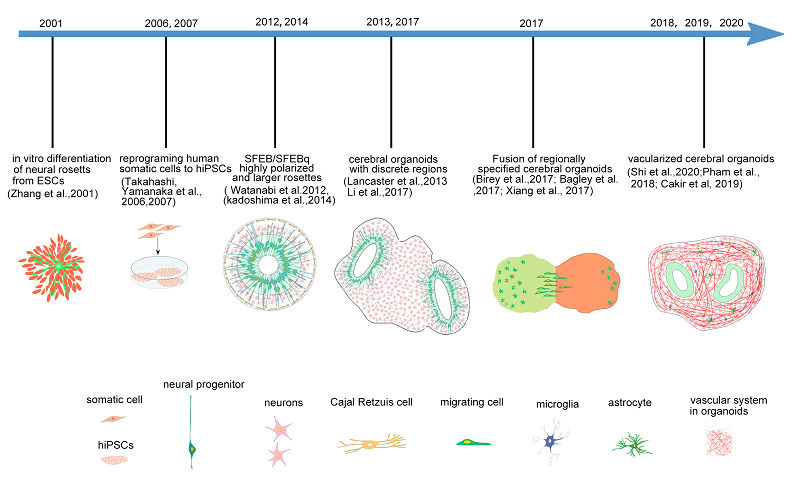IBP Laboratory Gives Introduction to Modeling Brain Organoids and Cultivation Technologies
At the invitation of the journal Current Opinion in Neurobiology, WANG Xiaoqun, a principal investigator from Institute of Biophysics, Chinese Academy of Sciences, published a research paper entitled "Modeling brain development and diseases with human cerebral organoids" in the journal on October 30.
A research team led by WANG has been committed to the studies relevant with the development and functions of the brain. For instance, it has undertaken systematic analyses of cellular types and characteristics during the development of human cortical embryos and uncovered the regulatory mechanism that causes human neurons to grow rapidly and produce gyrus (Liu et al., 2017; Zhong et al., 2018). Early in 2012, WANG and his teammates pioneered to develop brain organoid technology, which was later applied to model microcephaly induced by the mutation of ASPM in vivo and explore its pathological features as well as mechanisms (Li et al., 2017).
The research team found a new method to obtain the vascularization of brain organoids this May. The method has offered a good solution to the lack of oxygen and nutrients that limit the long-term development of brain-like organs (Shi et al., 2020). Researchers confirmed that human umbilical vein endothelial cells (HUVECs) can be nurtured together with human embryonic stem cells to form complicated vascular networks in brain organoids in a move to better deal with the shortage of oxygen in cells and cellular death in brain-like organs. In addition, their work showed that HUVECs vascular networks can accelerate the early maturation of brain-like organs. After internal transplantation, the endothelial cells in the vascular network of brain-like organs can be integrated into the host mouse's vessel to form a new functional vascular network with a blood flow (Shi et al., 2020).
It is an important topic to explore the developmental mechanism of human brain and the nosogenesis of neurological and psychiatric disorders. The current perception and understanding of neocortical development are mainly derived from cellular and molecular studies in rodents because of the poor accessibility of human and non-human primate brain tissues. Although rodent models have been used to reveal many key features of neocortical development that are general in mammals, such as six-layer cortical organization and regionalization of different functional areas, there are many differences in brain development between humans and rodents.
Technological development of induced pluripotent stem cells (iPSCs) and the fast growth of 3D culture have together facilitated the generation of three-dimensional neural tissues that recapitulate the major features of human development in vitro, termed brain organoids. A number of studies have demonstrated that brain organoids have the ability to recapitulate in vivo processes such as neurogenesis, neuronal migration, neuronal positioning, laminar organization and the formation of neural circuitry. In addition, thanks to the accessibility to iPSCs derived from patients with genetic diseases, brain organoids have been widely applied to explore the nosogenesis of neurological and neuropsychiatric diseases. As it is relatively easier to get lots of brain organoids in vitro, such brain-like organs have obvious advantages in revealing the mysteries of genetic bases of human neurodevelopmental and neuropsychiatric disorders when compared with animal models.
To help readers have a comprehensive understanding of brain organoids, this research paper first makes a review of their development process and gave introductions to some groundbreaking research progresses. For instance, researchers such as Yoshiki Sasai established the serum-free embryoid bodies (SFEB) method; Lancaster in 2013 developed fresh methods to cultivate cerebral organoids that contained interdependent brain regions. It then sums up cultivation plans available for brain organoids and makes an explanation of them with illustrations, aiming to better meet the needs of relevant readers.
The paper gives an introduction to current applications of brain organoids through modeling the development of human neurological system and the occurrence of neuropsychiatric disorders. Brain-like organs have natural advantages in the exploration of neural precursor cells such as oRGs (outer Radial glial cells) and developmental characteristics only known to human beings. Moreover, they have also shown unique advantages in uncovering the pathology of brain diseases via modeling neural development disorders and neurodegenerative diseases.
Although scientists have already made lots of achievements and innovation in the research of brain organoids, there are several pressing issues yet to be resolved. For instance, efforts should be made to improve the recyclable utility of brain organoids and cope with oxygen depletion and cellular death. Therefore, the research paper gives a detailed introduction to those issues and current work designed to resolve these questions.
As an emerging focus in scientific research, the studies of brain organoids have witnessed a robust growth in recent years. The research paper is designed to further raise public interest in brain organoids and make the academic sector clearer.

Big events of the development and innovative progress of brain organoids
(Image by Dr. WANG Xiaoqun's group)
The web link for this paper is
https://www.sciencedirect.com/science/article/pii/S0959438820301331
Contact: WANG Xiaoqun
Institute of Biophysics, Chinese Academy of Sciences
Beijing 100101, China
Email: xiaoqunwang@ibp.ac.cn
(Reported by Dr. WANG Xiaoqun's group)

